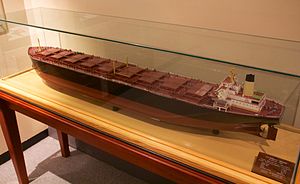M.v. Derbyshire

The Derbyshire's sister ship, the Kowloon Bridge
|
|
| History | |
|---|---|
|
|
|
| Name: |
|
| Owner: | Bibby Line |
| Port of registry: |
|
| Builder: | Swan Hunter |
| Yard number: | 57 |
| Launched: | 5 December 1975 |
| Completed: | June 1976 |
| Identification: | IMO number: 7343805Call sign: GULK |
| Fate: | Lost on 9 September 1980 during Typhoon Orchid, 44 people (42 crewmen and two wives) killed, wreck located 25°30′N 130°30′E / 25.500°N 130.500°E |
| Status: | Wreck |
| Notes: | Largest British ship ever lost at sea |
| General characteristics | |
| Class and type: | Bridge-class combination carrier |
| Tonnage: | |
| Length: | 294.2 m (965 ft 3 in) |
| Beam: | 44.3 m (145 ft 4 in) |
| Draft: | 18.44 m (60 ft 6 in) |
| Ice class: | A1 |
| Installed power: | B&W 8K98FF |
| Propulsion: | 1x propeller |
| Speed: | 15.5 knots (28.7 km/h; 17.8 mph) |
| Capacity: | c. 160,000 tonnes of cargo |
| Crew: | 42 |
MV Derbyshire was an ore-bulk-oil combination carrier built in 1976 by Swan Hunter, as the last in the series of the Bridge-class sextet. She was registered at Liverpool and owned by Bibby Line.
She was lost on 9 September 1980 during Typhoon Orchid, south of Japan. All 42 crew members and two of their wives were killed in the sinking. At 91,655 gross register tons, she was—and remains—the largest British ship ever to have been lost at sea.
Derbyshire was launched in late 1975 and entered service in June 1976, as the last ship of the Bridge-class combination carrier, originally named Liverpool Bridge. Liverpool Bridge and English Bridge (later Worcestershire, later Kowloon Bridge) were built by Seabridge for Bibby Line. The ship was laid up for two of its four years of service life.
In 1978, Liverpool Bridge was renamed Derbyshire, the fourth vessel to carry the name in the company's fleet. On 11 July 1980, on what turned out to be the vessel's final voyage, Derbyshire left Sept-Îles, Canada, her destination being Kawasaki, Japan, though she foundered near Okinawa (Southern Japan). Derbyshire was carrying a cargo of 157,446 tonnes of iron ore.
On 9 September 1980, Derbyshire hove-to in Typhoon Orchid some 230 miles from Okinawa, and was overwhelmed by the tropical storm killing all aboard. Derbyshire never issued a Mayday distress message. The vessel had been following weather routing advice by "Ocean routes", a commercial weather routing company (subsequently renamed WRI Weather routing incorporated).
...
Wikipedia
